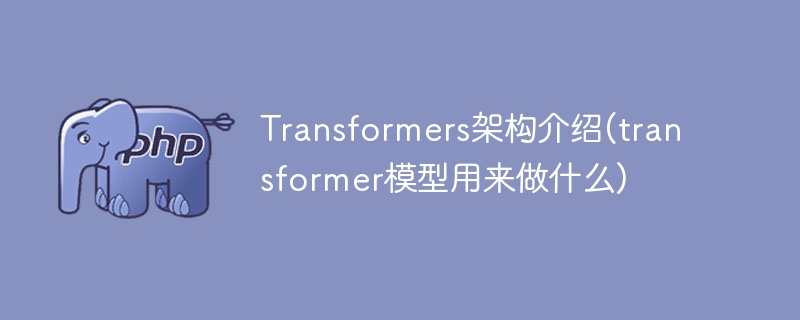Introduction to Transformer model application

Transformers is a model that uses a self-attention mechanism, which adopts an encoder-decoder architecture to achieve results. Some common Transformer architecture-based models include BERT and RoBERTa.
The Transformer architecture is specially designed to handle sequence-to-sequence problems in natural language processing tasks. Compared with traditional RNN, LSTM and other architectures, the main advantage of Transformer lies in its unique self-attention mechanism. This mechanism enables Transformer to accurately capture long-range dependencies and correlations between tokens in input sentences and greatly reduces computing time. Through the self-attention mechanism, Transformer can adaptively weight each position in the input sequence to better capture contextual information at different positions. This mechanism makes the Transformer more effective in handling long-distance dependencies, resulting in excellent performance in many natural language processing tasks.
This architecture is based on encoder-decoder and consists of multiple layers of encoders and decoders. Each encoder contains multiple sub-layers, including a multi-head self-attention layer and a positional fully connected feed-forward neural network. Likewise, each decoder also has the same two sub-layers, with the addition of a third sub-layer called the encoder-decoder attention layer, which is applied to the output of the encoder stack.
There is a normalization layer after each sub-layer, and there are residual connections around each feedforward neural network. This residual connection provides a free path for gradient and data flow, helping to avoid vanishing gradient problems when training deep neural networks.
The encoder's attention vector is passed to the feedforward neural network, which converts it into a vector representation and passes it to the next attention layer. The decoder’s task is to transform the encoder’s attention vector into output data. During the training phase, the decoder can use the attention vectors and expected results generated by the encoder.
The decoder uses the same tokenization, word embedding and attention mechanisms to process the expected results and generate attention vectors. This attention vector then interacts with the attention layer in the encoder module to establish the association between the input and output values. The decoder attention vector is processed by the feedforward layer and then mapped into a large vector of the target data size.
The above is the detailed content of Introduction to Transformer model application. For more information, please follow other related articles on the PHP Chinese website!

Hot AI Tools

Undresser.AI Undress
AI-powered app for creating realistic nude photos

AI Clothes Remover
Online AI tool for removing clothes from photos.

Undress AI Tool
Undress images for free

Clothoff.io
AI clothes remover

AI Hentai Generator
Generate AI Hentai for free.

Hot Article

Hot Tools

Notepad++7.3.1
Easy-to-use and free code editor

SublimeText3 Chinese version
Chinese version, very easy to use

Zend Studio 13.0.1
Powerful PHP integrated development environment

Dreamweaver CS6
Visual web development tools

SublimeText3 Mac version
God-level code editing software (SublimeText3)

Hot Topics
 1376
1376
 52
52
 I Tried Vibe Coding with Cursor AI and It's Amazing!
Mar 20, 2025 pm 03:34 PM
I Tried Vibe Coding with Cursor AI and It's Amazing!
Mar 20, 2025 pm 03:34 PM
Vibe coding is reshaping the world of software development by letting us create applications using natural language instead of endless lines of code. Inspired by visionaries like Andrej Karpathy, this innovative approach lets dev
 Top 5 GenAI Launches of February 2025: GPT-4.5, Grok-3 & More!
Mar 22, 2025 am 10:58 AM
Top 5 GenAI Launches of February 2025: GPT-4.5, Grok-3 & More!
Mar 22, 2025 am 10:58 AM
February 2025 has been yet another game-changing month for generative AI, bringing us some of the most anticipated model upgrades and groundbreaking new features. From xAI’s Grok 3 and Anthropic’s Claude 3.7 Sonnet, to OpenAI’s G
 How to Use YOLO v12 for Object Detection?
Mar 22, 2025 am 11:07 AM
How to Use YOLO v12 for Object Detection?
Mar 22, 2025 am 11:07 AM
YOLO (You Only Look Once) has been a leading real-time object detection framework, with each iteration improving upon the previous versions. The latest version YOLO v12 introduces advancements that significantly enhance accuracy
 Is ChatGPT 4 O available?
Mar 28, 2025 pm 05:29 PM
Is ChatGPT 4 O available?
Mar 28, 2025 pm 05:29 PM
ChatGPT 4 is currently available and widely used, demonstrating significant improvements in understanding context and generating coherent responses compared to its predecessors like ChatGPT 3.5. Future developments may include more personalized interactions and real-time data processing capabilities, further enhancing its potential for various applications.
 Google's GenCast: Weather Forecasting With GenCast Mini Demo
Mar 16, 2025 pm 01:46 PM
Google's GenCast: Weather Forecasting With GenCast Mini Demo
Mar 16, 2025 pm 01:46 PM
Google DeepMind's GenCast: A Revolutionary AI for Weather Forecasting Weather forecasting has undergone a dramatic transformation, moving from rudimentary observations to sophisticated AI-powered predictions. Google DeepMind's GenCast, a groundbreak
 Which AI is better than ChatGPT?
Mar 18, 2025 pm 06:05 PM
Which AI is better than ChatGPT?
Mar 18, 2025 pm 06:05 PM
The article discusses AI models surpassing ChatGPT, like LaMDA, LLaMA, and Grok, highlighting their advantages in accuracy, understanding, and industry impact.(159 characters)
 o1 vs GPT-4o: Is OpenAI's New Model Better Than GPT-4o?
Mar 16, 2025 am 11:47 AM
o1 vs GPT-4o: Is OpenAI's New Model Better Than GPT-4o?
Mar 16, 2025 am 11:47 AM
OpenAI's o1: A 12-Day Gift Spree Begins with Their Most Powerful Model Yet December's arrival brings a global slowdown, snowflakes in some parts of the world, but OpenAI is just getting started. Sam Altman and his team are launching a 12-day gift ex
 Best AI Art Generators (Free & Paid) for Creative Projects
Apr 02, 2025 pm 06:10 PM
Best AI Art Generators (Free & Paid) for Creative Projects
Apr 02, 2025 pm 06:10 PM
The article reviews top AI art generators, discussing their features, suitability for creative projects, and value. It highlights Midjourney as the best value for professionals and recommends DALL-E 2 for high-quality, customizable art.




